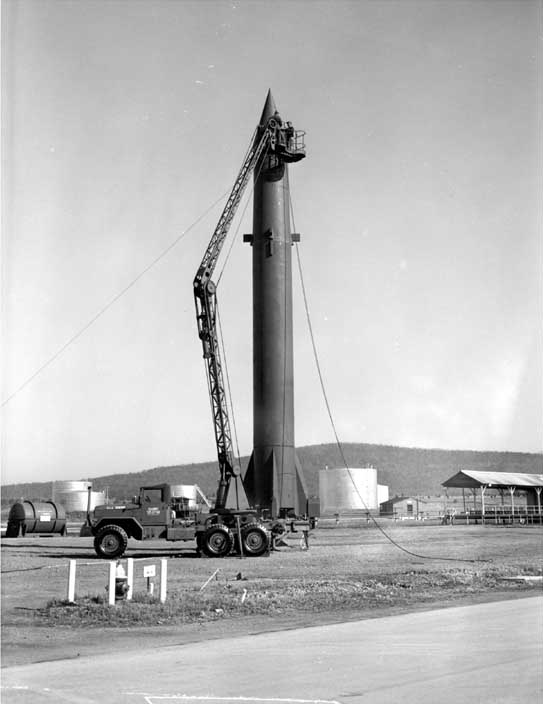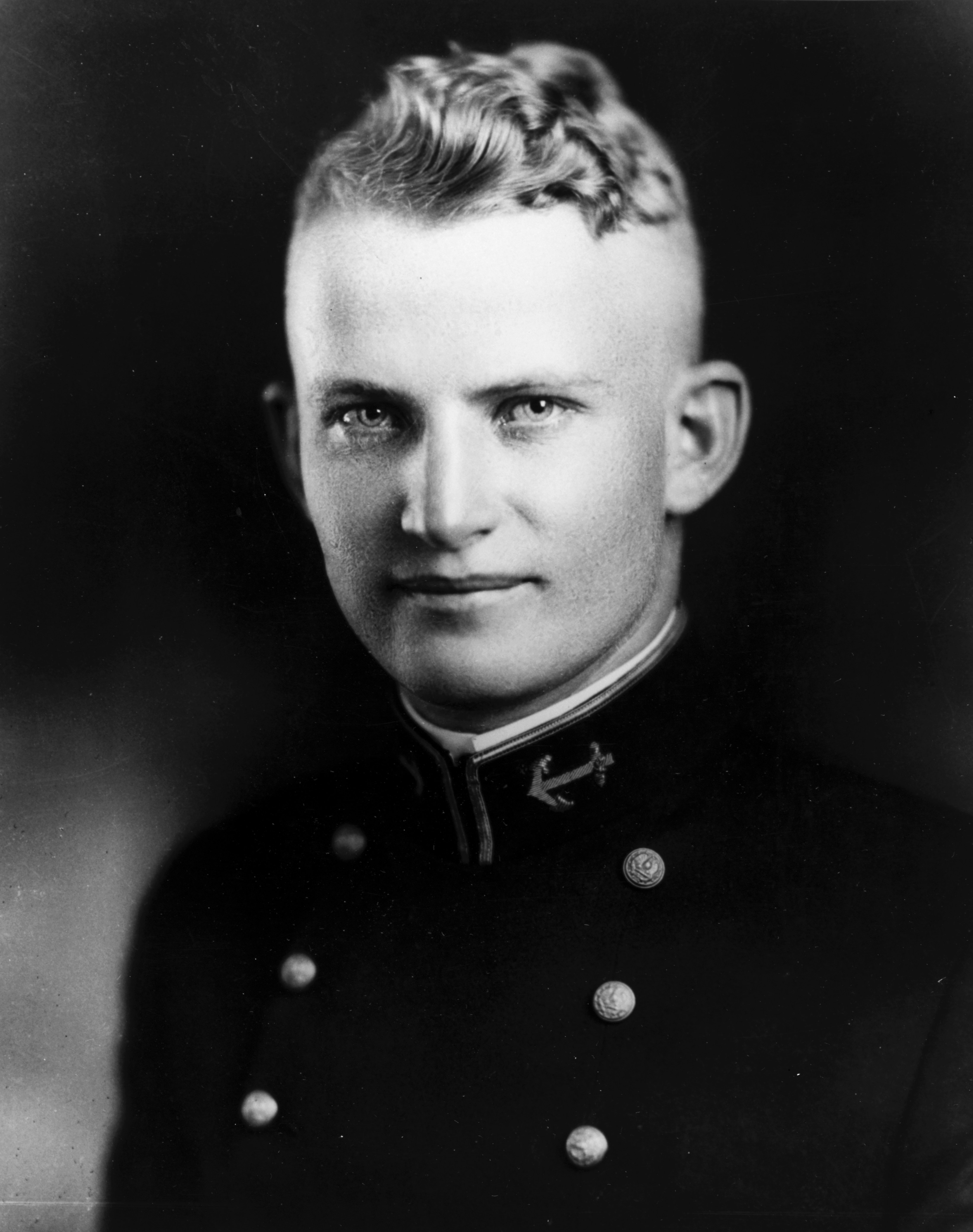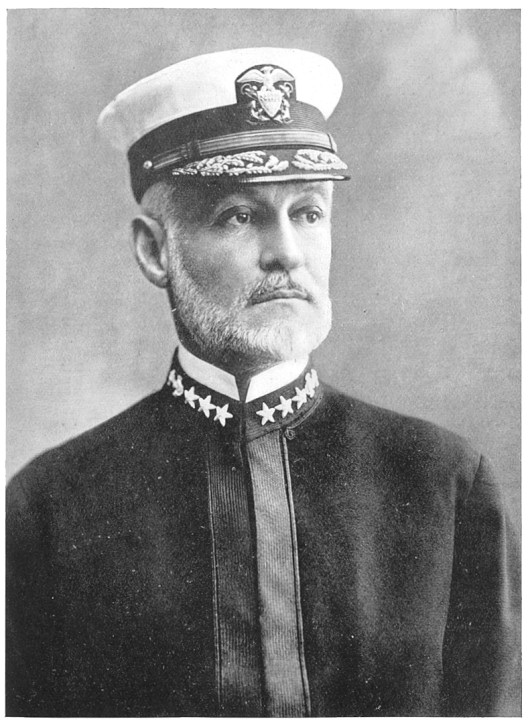|
PGM-19
The PGM-19 Jupiter was the first nuclear armed, medium-range ballistic missile (MRBM) of the United States Air Force (USAF). It was a liquid-propellant rocket using RP-1 fuel and LOX oxidizer, with a single Rocketdyne LR79-NA (model S-3D) rocket engine producing of thrust. It was armed with the W49 nuclear warhead. The prime contractor was the Chrysler Corporation. The Jupiter was originally designed by the US Army, which was looking for a highly accurate missile designed to strike enemy states such as Communist China and USSR. The US Navy also expressed an interest in the design as an SLBM but left the collaboration to work on their Polaris. Jupiter retained the short, squat shape intended to fit in naval submarines. Development history Initial concept Jupiter traces its history ultimately to the PGM-11 Redstone missile, the US's first nuclear ballistic missile. While it was entering service, Wernher von Braun's Army Ballistic Missile Agency (ABMA) team at Redst ... [...More Info...] [...Related Items...] OR: [Wikipedia] [Google] [Baidu] |
Chrysler Corporation
Stellantis North America (officially FCA US and formerly Chrysler ()) is one of the " Big Three" automobile manufacturers in the United States, headquartered in Auburn Hills, Michigan. It is the American subsidiary of the multinational automotive company Stellantis. In addition to the Chrysler brand, Stellantis North America sells vehicles worldwide under the Dodge, Jeep, and Ram nameplates. It also includes Mopar, its automotive parts and accessories division, and SRT, its performance automobile division. The original Chrysler Corporation was founded in 1925 by Walter Chrysler from the remains of the Maxwell Motor Company. It was acquired by Daimler-Benz, which in 1998 renamed itself DaimlerChrysler. After Daimler divested Chrysler in 2007, the company operated as Chrysler LLC (2007–2009) and Chrysler Group LLC (2009–2014) before being acquired by Fiat S.p.A. and becoming a subsidiary of the newly formed Fiat Chrysler Automobiles ("FCA") in 2014. Chrysler in 2021 is a ... [...More Info...] [...Related Items...] OR: [Wikipedia] [Google] [Baidu] |
Rocketdyne S-3D
The Rocketdyne S-3D is an American liquid rocket engine produced by Rocketdyne between 1956 and 1961 for use on the PGM-19 Jupiter and PGM-17 Thor missiles, and the Juno II rocket. Its design was used later as the basis for the H-1 rocket engine of the Saturn I, and the Rolls-Royce RZ.2 of the Blue Streak Blue Streak or Bluestreak may refer to: Entertainment * ''Blue Streak'' (album), a 1995 album by American blues guitarist Luther Allison * Blue Streak (comics), a secret identity used by three separate Marvel Comics supervillains * Bluestreak (co .... It belongs to the LR79 engine family. References {{Rocket engines S-3D Rocket engines of the United States Rocket engines using the gas-generator cycle ... [...More Info...] [...Related Items...] OR: [Wikipedia] [Google] [Baidu] |
Army Ballistic Missile Agency
The Army Ballistic Missile Agency (ABMA) was formed to develop the United States Army, U.S. Army's first large ballistic missile. The agency was established at Redstone Arsenal on 1 February 1956, and commanded by Major General John Bruce Medaris, John B. Medaris with Wernher von Braun as technical director. History The Redstone (rocket), Redstone missile was the first major project assigned to ABMA. The Redstone was a direct descendant of the V-2 missile developed by the von Braun team in Germany during World War II. After the Naval Research Laboratory's Project Vanguard was chosen by the United States Department of Defense, DoD Committee on Special Capabilities, over the ABMA's proposal to use a modified Redstone (rocket), Redstone ballistic missile as a satellite launch vehicle, ABMA was ordered to stop work on launchers for satellites and focus, instead, on military missiles. Von Braun continued work on the design for what became the Jupiter-C rocket. This was a three-st ... [...More Info...] [...Related Items...] OR: [Wikipedia] [Google] [Baidu] |
UGM-27 Polaris
The UGM-27 Polaris missile was a two-stage solid-fueled nuclear-armed submarine-launched ballistic missile (SLBM). As the United States Navy's first SLBM, it served from 1961 to 1980. In the mid-1950s the Navy was involved in the Jupiter missile project with the U.S. Army, and had influenced the design by making it squat so it would fit in submarines. However, they had concerns about the use of liquid fuel rockets on board ships, and some consideration was given to a solid fuel version, Jupiter S. In 1956, during an anti-submarine study known as Project Nobska, Edward Teller suggested that very small hydrogen bomb warheads were possible. A crash program to develop a missile suitable for carrying such warheads began as Polaris, launching its first shot less than four years later, in February 1960. As the Polaris missile was fired underwater from a moving platform, it was essentially invulnerable to counterattack. This led the Navy to suggest, starting around 1959, that they be g ... [...More Info...] [...Related Items...] OR: [Wikipedia] [Google] [Baidu] |
SLBM
A submarine-launched ballistic missile (SLBM) is a ballistic missile capable of being launched from Ballistic missile submarine, submarines. Modern variants usually deliver multiple independently targetable reentry vehicles (MIRVs), each of which carries a thermonuclear weapon, nuclear warhead and allows a single launched missile to strike several targets. Submarine-launched ballistic missiles operate in a different way from submarine-launched cruise missiles. Modern submarine-launched ballistic missiles are closely related to intercontinental ballistic missiles (ICBMs), with ranges of over , and in many cases SLBMs and ICBMs may be part of the same family of weapons. History Origins The first practical design of a submarine-based launch platform was developed by the Germans near the end of World War II involving a launch tube which contained a V-2 rocket, V-2 ballistic missile variant and was towed behind a submarine, known by the code-name V-2 rocket#Unfulfilled plans, ''Prüf ... [...More Info...] [...Related Items...] OR: [Wikipedia] [Google] [Baidu] |
Medium-range Ballistic Missile
A medium-range ballistic missile (MRBM) is a type of ballistic missile with medium range, this last classification depending on the standards of certain organizations. Within the U.S. Department of Defense, a medium-range missile is defined by having a maximum range of between . In modern terminology, MRBMs are part of the wider grouping of theatre ballistic missiles, which includes any ballistic missile with a range of less than . Specific MRBMs * DF-2 * DF-16 * DF-17 * DF-21 (China) , (Saudi Arabia) * SSBS S1 * Agni II * Agni-P * Ashoura * Emad * Fajr-3 (estimation) * Ghadr-110 * Khorramshahr (missile) * Sejjil * Shahab-3 * Badr-2000 * Jericho II * Hwasong-9 * Hwasong-10/RD-B Musudan * Pukkuksong-1 * Pukkuksong-2 * Pukkuksong-2 * Rodong-1 * Ababeel * Ghauri-I * Ghauri-II * Ghauri-III (Cancelled) * Shaheen-II * Shaheen-III [...More Info...] [...Related Items...] OR: [Wikipedia] [Google] [Baidu] |
Medium-range Ballistic Missile
A medium-range ballistic missile (MRBM) is a type of ballistic missile with medium range, this last classification depending on the standards of certain organizations. Within the U.S. Department of Defense, a medium-range missile is defined by having a maximum range of between . In modern terminology, MRBMs are part of the wider grouping of theatre ballistic missiles, which includes any ballistic missile with a range of less than . Specific MRBMs * DF-2 * DF-16 * DF-17 * DF-21 (China) , (Saudi Arabia) * SSBS S1 * Agni II * Agni-P * Ashoura * Emad * Fajr-3 (estimation) * Ghadr-110 * Khorramshahr (missile) * Sejjil * Shahab-3 * Badr-2000 * Jericho II * Hwasong-9 * Hwasong-10/RD-B Musudan * Pukkuksong-1 * Pukkuksong-2 * Pukkuksong-2 * Rodong-1 * Ababeel * Ghauri-I * Ghauri-II * Ghauri-III (Cancelled) * Shaheen-II * Shaheen-III [...More Info...] [...Related Items...] OR: [Wikipedia] [Google] [Baidu] |
Arleigh Burke
Arleigh Albert Burke (October 19, 1901 – January 1, 1996) was an admiral of the United States Navy who distinguished himself during World War II and the Korean War, and who served as Chief of Naval Operations during the Eisenhower and Kennedy administrations. , the lead ship of its class of Aegis-equipped guided missile destroyers, was commissioned in Burke's honor in 1991. The honor of naming a vessel after a living figure was only the fourth time it had been bestowed since 1861. Early life and naval career Burke was born in Boulder, Colorado, on October 19, 1901, to Oscar Burke and Clara Mokler. His grandfather, August Björkgren, was a Swedish immigrant to the US and changed his surname to 'Burke', a common Irish surname, to sound more 'American'. Due to the 1918 influenza outbreak, schools were closed in Boulder and he never graduated from high school. Burke won an alternate appointment to the United States Naval Academy given by his local congressman. During his ... [...More Info...] [...Related Items...] OR: [Wikipedia] [Google] [Baidu] |
Rocketdyne
Rocketdyne was an American rocket engine design and production company headquartered in Canoga Park, California, Canoga Park, in the western San Fernando Valley of suburban Los Angeles, California, Los Angeles, in southern California. The Rocketdyne Division was founded by North American Aviation (NAA) in 1955, and was later part of Rockwell International (1967–1996) and Boeing (1996–2005). In 2005, the Rocketdyne Division was sold to United Technologies Corporation, becoming Pratt & Whitney Rocketdyne as part of Pratt & Whitney. In 2013, Pratt & Whitney Rocketdyne was sold to GenCorp, which merged it with Aerojet to form Aerojet Rocketdyne.Marjorie Censer(18 Dec 2022) L3Harris moves to acquire Aerojet Rocketdynefor $4.7 billion, after Lockheed Martin ended its attempt for Rocketdyne in Feb 2022 History After World War II, North American Aviation (NAA) was contracted by the Defense Department to study the German V-2, V-2 missile and adapt its engine to Society of Automotiv ... [...More Info...] [...Related Items...] OR: [Wikipedia] [Google] [Baidu] |
Killian Committee
The President's Science Advisory Committee (PSAC) was created on November 21, 1957, by President of the United States Dwight D. Eisenhower, as a direct response to the Soviet launching of the Sputnik 1 and Sputnik 2 satellites. PSAC was an upgrade and move to the White House of the Science Advisory Committee (SAC) established in 1951 by President Harry S. Truman, as part of the Office of Defense Mobilization (ODM). Its purpose was to advise the president on scientific matters in general, and those related to defense issues in particular. Eisenhower appointed James R. Killian as PSAC's first director. In 1961, President John F. Kennedy renamed the agency the Office of Science and Technology (OST). This lasted until Richard Nixon's administration in 1973. In 1976 the Office of Science and Technology Policy was established. First report The first report of the newly formed Science Advisory Committee, commonly known as the Killian Report (February 14, 1955, officially "Meeting the Thre ... [...More Info...] [...Related Items...] OR: [Wikipedia] [Google] [Baidu] |
Robert B
The name Robert is an ancient Germanic given name, from Proto-Germanic "fame" and "bright" (''Hrōþiberhtaz''). Compare Old Dutch ''Robrecht'' and Old High German ''Hrodebert'' (a compound of '' Hruod'' ( non, Hróðr) "fame, glory, honour, praise, renown" and ''berht'' "bright, light, shining"). It is the second most frequently used given name of ancient Germanic origin. It is also in use as a surname. Another commonly used form of the name is Rupert. After becoming widely used in Continental Europe it entered England in its Old French form ''Robert'', where an Old English cognate form (''Hrēodbēorht'', ''Hrodberht'', ''Hrēodbēorð'', ''Hrœdbœrð'', ''Hrœdberð'', ''Hrōðberχtŕ'') had existed before the Norman Conquest. The feminine version is Roberta. The Italian, Portuguese, and Spanish form is Roberto. Robert is also a common name in many Germanic languages, including English, German, Dutch, Norwegian, Swedish, Scots, Danish, and Icelandic. It can be use ... [...More Info...] [...Related Items...] OR: [Wikipedia] [Google] [Baidu] |
Chief Of Naval Operations
The chief of naval operations (CNO) is the professional head of the United States Navy. The position is a statutory office () held by an admiral who is a military adviser and deputy to the secretary of the Navy. In a separate capacity as a member of the Joint Chiefs of Staff (), the CNO is a military adviser to the United States National Security Council, National Security Council, the United States Homeland Security Council, Homeland Security Council, the United States Secretary of Defense, secretary of defense, and the President of the United States, president. The current chief of naval operations is Michael M. Gilday, Admiral Michael M. Gilday. Despite the title, the CNO does not have operational command authority over naval forces. The CNO is an administrative position based in the Pentagon, and exercises supervision of Navy organizations as the designee of the secretary of the Navy. Operational command of naval forces falls within the purview of the Unified combatant comma ... [...More Info...] [...Related Items...] OR: [Wikipedia] [Google] [Baidu] |



_(2).jpg)


